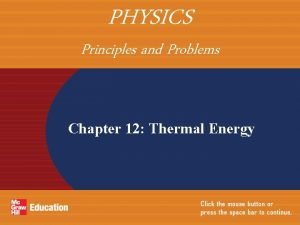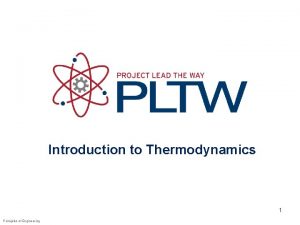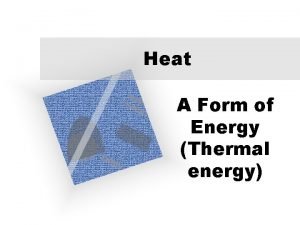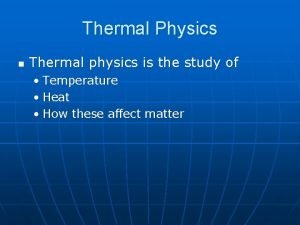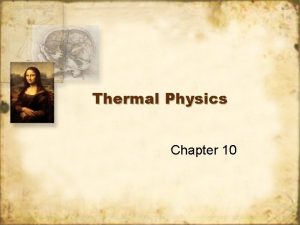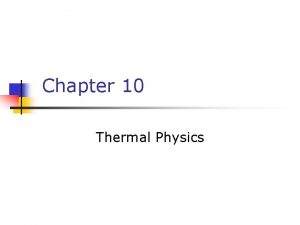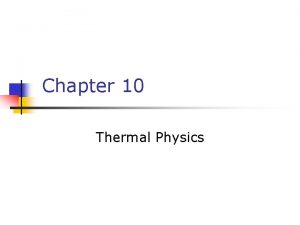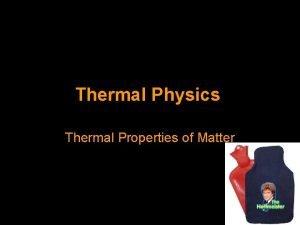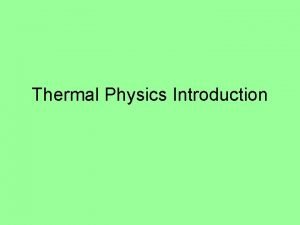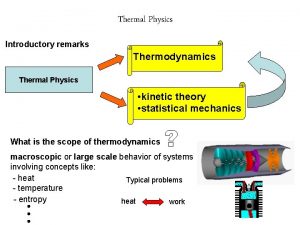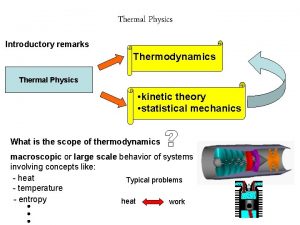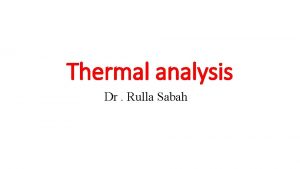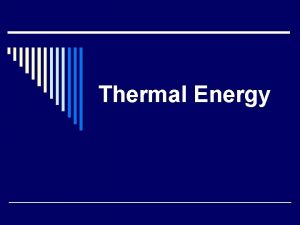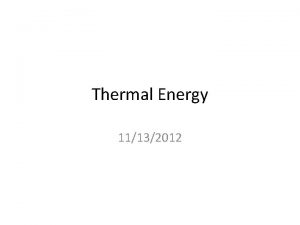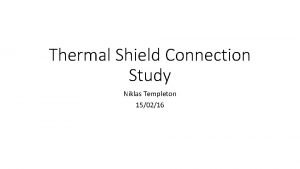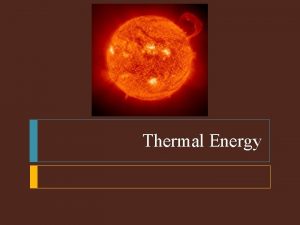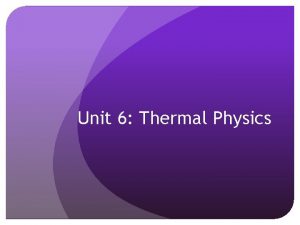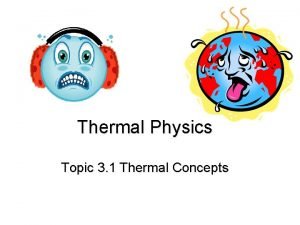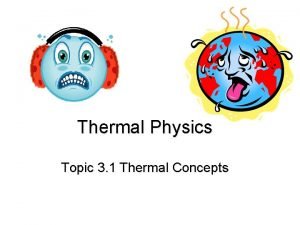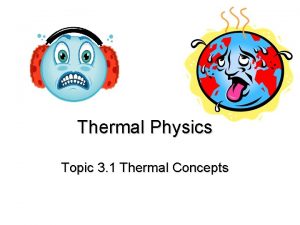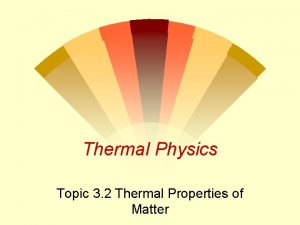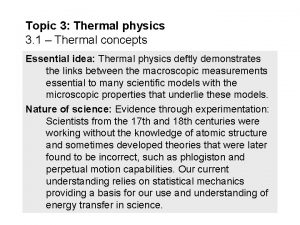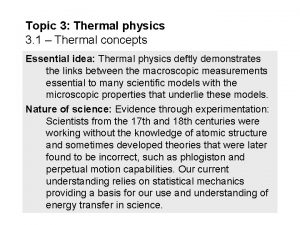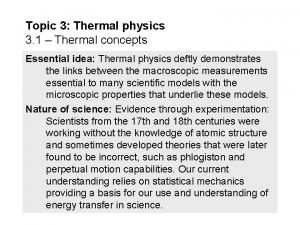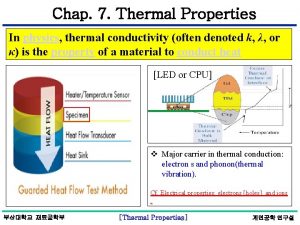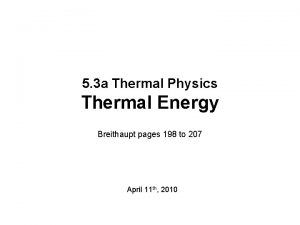Thermal Physics n Thermal physics is the study































- Slides: 31

Thermal Physics n Thermal physics is the study of • Temperature • Heat • How these affect matter

Thermal Physics, cont n n n Concerned with the concepts of energy transfers between a system and its environment and the resulting temperature variations Historically, the development of thermodynamics paralleled the development of atomic theory Concerns itself with the physical and chemical transformations of matter in all of its forms: solid, liquid, and gas

Zeroth Law of Thermodynamics n n If objects A and B are separately in thermal equilibrium with a third object, C, then A and B are in thermal equilibrium with each other. Allows a definition of temperature

Temperature from the Zeroth Law n n Two objects in thermal equilibrium with each other are at the same temperature Temperature is the property that determines whether or not an object is in thermal equilibrium with other objects

Thermometers n n n Used to measure the temperature of an object or a system Make use of physical properties that change with temperature Many physical properties can be used • • • volume of a liquid length of a solid pressure of a gas held at constant volume of a gas held at constant pressure electric resistance of a conductor color of a very hot object

Thermometers, cont n n n A mercury thermometer is an example of a common thermometer The level of the mercury rises due to thermal expansion Temperature can be defined by the height of the mercury column

Temperature Scales n Thermometers can be calibrated by placing them in thermal contact with an environment that remains at constant temperature • Environment could be mixture of ice and water in thermal equilibrium • Also commonly used is water and steam in thermal equilibrium

Celsius Scale n Temperature of an ice-water mixture is defined as 0º C • This is the freezing point of water n Temperature of a water-steam mixture is defined as 100º C • This is the boiling point of water n Distance between these points is divided into 100 segments or degrees

Gas Thermometer n n Temperature readings are nearly independent of the gas Pressure varies with temperature when maintaining a constant volume

Kelvin Scale n n n When the pressure of a gas goes to zero, its temperature is – 273. 15º C This temperature is called absolute zero This is the zero point of the Kelvin scale • – 273. 15º C = 0 K n To convert: TC = TK – 273. 15 • The size of the degree in the Kelvin scale is the same as the size of a Celsius degree

Pressure-Temperature Graph n n All gases extrapolate to the same temperature at zero pressure This temperature is absolute zero

Modern Definition of Kelvin Scale n Defined in terms of two points • Agreed upon by International Committee on Weights and Measures in 1954 n n First point is absolute zero Second point is the triple point of water • Triple point is the single point where water can exist as solid, liquid, and gas • Single temperature and pressure • Occurs at 0. 01º C and P = 4. 58 mm Hg

Modern Definition of Kelvin Scale, cont n n The temperature of the triple point on the Kelvin scale is 273. 16 K Therefore, the current definition of of the Kelvin is defined as 1/273. 16 of the temperature of the triple point of water

Some Kelvin Temperatures n n n Some representative Kelvin temperatures Note, this scale is logarithmic Absolute zero has never been reached

Fahrenheit Scales n n Most common scale used in the US Temperature of the freezing point is 32º Temperature of the boiling point is 212º 180 divisions between the points

Comparing Temperature Scales

Converting Among Temperature Scales

Equation of State n n n Pressure(P), volume(V), temperature(T), and amount of substance(m) are called state variables State variables are connected Relationship between state variables is the equation of state

Ideal Gas n n n A gas does not have a fixed volume or pressure In a container, the gas expands to fill the container Most gases at room temperature and pressure behave approximately as an ideal gas

Characteristics of an Ideal Gas n n n Collection of atoms or molecules that move randomly Exert no long-range force on one another Each particle is individually point-like • Occupying a negligible volume

Moles n It’s convenient to express the amount of gas in a given volume in terms of the number of moles, n n: number of moles m: mass of gas M: molecular mass n One mole is the amount of the substance that contains as many particles as there atoms in 12 g of carbon-12

Avogadro’s Number n The number of particles in a mole is called Avogadro’s Number • NA=6. 02 x 1023 particles / mole • Defined so that 12 g of carbon contains NA atoms n The mass of an individual atom can be calculated:

Avogadro’s Number and Masses n n The mass in grams of one Avogadro's number of an element is numerically the same as the mass of one atom of the element, expressed in atomic mass units, u Carbon has a mass of 12 u • 12 g of carbon consists of NA atoms of carbon n Holds for molecules, also

Road to Ideal Gas Law n n n V is proportional to the number of moles n (keep P and T constant) If T is constant, PV=constant (Boyle’s law) If P is constant, V T (Gay-Lussac’s law)

Ideal Gas Law n PV = n R T • R is the Universal Gas Constant • R = 8. 31 J / mole. K • R = 0. 0821 L. atm / mole. K • Is the equation of state for an ideal gas

Ideal Gas Law, cont n n Good approximation for real gas at low pressure, quite good at moderate pressure For a given amount of gas

Ideal Gas Law, more n Standard pressure and temperature (P=1 atm, T=0 °C=273 °K)

Ideal Gas Law, more n n Partial pressure concept– total pressure is the sum of partial pressure of the components Air: O 2, N 2, C O 2, Water vapor, etc.

Example A tank of volume 590 liters contains oxygen at 20 °C and at 5 atm. Calculate the mass of oxygen in the tank. (M=32 kg/kmole for oxygen or 32 g/mole)

Example An ideal gas has volume 1 liter at 1 atm and – 20 °C. How many atm must it be subjected to when compressed to 0. 5 liter at a temperature of 40 °C?

Example The cork of a popgun is inserted so tightly that a pressure of 3 atm is required to dislodge it. Air is admitted through a hole at A, which is 24 cm from the cork at B. How far from A is the piston when the cork pops out, assuming no temperature change?
 Ib physics ia samples
Ib physics ia samples Thermal energy section 3 using thermal energy
Thermal energy section 3 using thermal energy Thermal transfer vs direct thermal printing
Thermal transfer vs direct thermal printing Chapter 12 thermal energy
Chapter 12 thermal energy Khan academy pn junction
Khan academy pn junction Thermal energy equation physics
Thermal energy equation physics Thermal energy equation
Thermal energy equation Thermal physics definition
Thermal physics definition Hát kết hợp bộ gõ cơ thể
Hát kết hợp bộ gõ cơ thể Lp html
Lp html Bổ thể
Bổ thể Tỉ lệ cơ thể trẻ em
Tỉ lệ cơ thể trẻ em Chó sói
Chó sói Tư thế worm breton
Tư thế worm breton Chúa yêu trần thế alleluia
Chúa yêu trần thế alleluia Các môn thể thao bắt đầu bằng tiếng đua
Các môn thể thao bắt đầu bằng tiếng đua Thế nào là hệ số cao nhất
Thế nào là hệ số cao nhất Các châu lục và đại dương trên thế giới
Các châu lục và đại dương trên thế giới Công thức tiính động năng
Công thức tiính động năng Trời xanh đây là của chúng ta thể thơ
Trời xanh đây là của chúng ta thể thơ Mật thư anh em như thể tay chân
Mật thư anh em như thể tay chân Làm thế nào để 102-1=99
Làm thế nào để 102-1=99 Phản ứng thế ankan
Phản ứng thế ankan Các châu lục và đại dương trên thế giới
Các châu lục và đại dương trên thế giới Thơ thất ngôn tứ tuyệt đường luật
Thơ thất ngôn tứ tuyệt đường luật Quá trình desamine hóa có thể tạo ra
Quá trình desamine hóa có thể tạo ra Một số thể thơ truyền thống
Một số thể thơ truyền thống Cái miệng bé xinh thế chỉ nói điều hay thôi
Cái miệng bé xinh thế chỉ nói điều hay thôi Vẽ hình chiếu vuông góc của vật thể sau
Vẽ hình chiếu vuông góc của vật thể sau Biện pháp chống mỏi cơ
Biện pháp chống mỏi cơ đặc điểm cơ thể của người tối cổ
đặc điểm cơ thể của người tối cổ V. c c
V. c c



